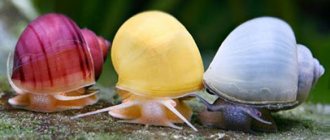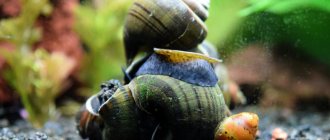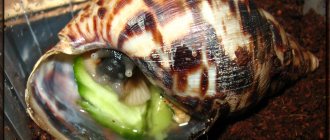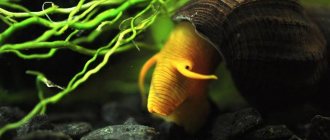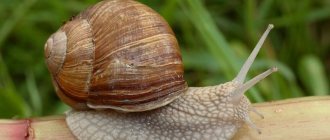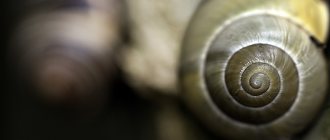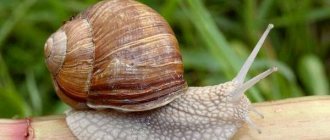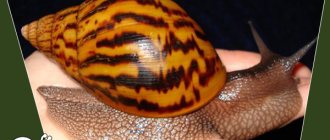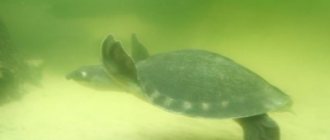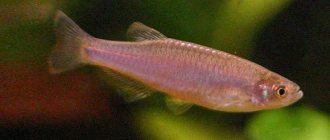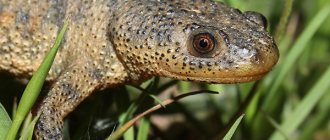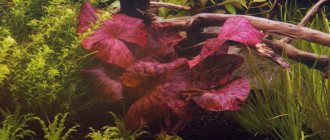Ampullaria aquarium snails are popular aquarium inhabitants native to South America. In nature, these mollusks reach a diameter of 11 cm, and in aquariums they rarely grow more than 6 cm. Reproduction of ampullaria in a home aquarium is possible if they are provided with a quality life. Unlike many small snails, giants rarely start laying eggs in unsuitable conditions.
Sex differences
Only females lay eggs.
This type of mollusk is heterosexual, and in order to produce offspring, the presence of males and females is necessary, while the vast majority of other aquarium snails are hermaphrodites. It is impossible to determine the gender of pets. There are no visible differences between individuals of different sexes . It is possible to distinguish a male apple from a female only at the moment of mating, during which he always remains on top. You can also determine the female by noticing which of the pets lays eggs.
To have individuals of both sexes in the aquarium, you need to buy at least 6 yellow snails. Among such a number, at least one individual of the opposite sex is ensured. If the ampullaria still do not reproduce, you need to check the conditions of their detention and, if they are in order, try to introduce a few more new snails.
Why ampularia do not reproduce
Mating and reproduction is a natural biological process that affects all living things. If there are no offspring from domestic gastropods for a long time, it is worth analyzing the following points:
- Both sexes are missing. If in doubt, it's better to buy a few more pieces;
- Snails have not yet reached reproductive age. Mollusks begin to breed no earlier than 1 year;
- Insufficient ambient temperature. The stimulus for sexual activity is an increase in temperature. At low rates, the mollusks will live, but the reproduction of heat-loving ampullary snails will be impossible.
- Lack of nutrition. It is important to make sure that the clams are not hungry.
- Little light. Ampoules need lighting at a rate of 1 W per liter.
By creating the right conditions for your pets, you can easily get offspring from them.
To breed these bright snails that look like multi-colored pebbles, no special skills or labor are required. Natural instinct will do its job on its own. It is necessary to organize conditions favorable for gastropods and add observation skills to help baby ampullaries be born.
Was this information useful to you? Share in the comments!
Conditions necessary for reproduction
Breeding ampularia at home is not difficult if certain conditions are created. They are necessary not only for producing offspring, but also simply for the quality of life of the ampoule. The main parameters necessary for the reproduction of mollusks are these three:
- Quality feeding. Snails cannot swim, which is why they feed on food from the bottom. If bottom dwellers or fish swimming on the surface overtake their armored neighbors and collect food from the bottom, then the latter will begin to eat plants, but they will not have enough of them. Due to a lack of nutrients, the snails will be quite weak and will not be able to produce full-fledged offspring.
- Keeping the water clean. Like fish, ampullaria require regular water changes in your home pond and mandatory cleaning of the bottom. This should be done at least once every 7 days. A quarter of the aquarium's volume needs to be replaced.
- The presence of space between the aquarium lid and the water. If there is not enough volume under the glass (lid) above the water, then the females will have nowhere to lay eggs, and reproduction will be impossible .
If all the necessary conditions are available in the aquarium, propagation of ampularia will not cause any difficulties. Snails, having reached sexual maturity, quickly begin to mate and lay eggs.
What to feed
Ampoules eat almost all types of dry food; they will not refuse live food , but then you need to provide access to it.
Snails love vegetables. To feed clams with cucumbers or zucchini, you need to prepare them - boil them a little.
You should not keep a portion in the tank for more than a day - the water may become very cloudy.
In addition, ampullaria eat up the leftover food from other inhabitants of the aquarium and will not refuse to taste ornamental plants.
Mating and laying eggs
Mating occurs after the snail has reached sexual maturity. This is usually indicated by its size, which reaches 4 cm. The type of ampoule (yellow, brown, black) does not matter. This indicator is the same for everyone. On average, ampularia are ready to mate at the age of 12 months. Giant clams live up to 4 years.
The male and female stick together with their soles, and at this moment fertilization occurs. The male is always on top, because of which it will be possible to determine the sex and mark it, so that in the future you will have an idea of what sex there are how many snails there are.
Video: Mating ampularia
After mating, the female climbs up the glass and crawls out of the water. In nature, it lays eggs on plants above water or on rocks on the shore. In a home aquarium, the snail uses glass above the water surface or a lid for this. If eggs fall into the water, they will die immediately . Even immediately removing it from the water, it will be impossible to save the embryos.
The most convenient way is to make a special plate for the snail to spawn. It is made of organic glass, which is glued to a strong suction cup using silicone sealant for aquariums. When it is noticed that mating has occurred, the plate is placed in the aquarium away from the lighting system so that it does not overheat the eggs. In addition, when attaching the glass for caviar, you need to position it in such a way that the fish cannot reach it. Many species will happily eat eggs if given the opportunity.
Ampularia spawning occurs in the evening or at night and always in the dark. When the ampullaria has laid eggs, it uses its foot to push the eggs towards each other so that they form a dense clutch. If the place chosen for spawning is good, then the ampullaria will lay eggs in it constantly.
Compatibility
Ampoules are completely harmless to fish, they are peaceful and calm . But fish (especially active barbs or cichlids) can offend mollusks by biting off their antennae.
Compatibility of apple turtles and red-eared turtles
Bad. Red-eared turtles are noticeably faster than snails, and the strength of their jaws is more than enough to break the shell of even a large snail.
Will Ampularia and Helena get along or not?
Predatory snails - helens - can, in principle, coexist with large ampullaria, provided there is a sufficient amount of food. But small ampularia from Helen are guaranteed to suffer .
Can ampularia eat fish?
No, she doesn't eat them. The snail will not eat live fish, but it can gnaw a corpse.
Appearance of caviar
The laying of ampularia is similar to a bunch of grapes.
The color of the eggs is whitish-transparent. The diameter of the eggs is 2 mm. They are deposited in clusters similar to grapes. The eggs are elastic and soft to the touch. As they mature, the eggs change color, becoming dark. Before the young snails hatch, the clutch turns out to be almost black. At such a moment, the caviar looks like a stone.
Lifehacks by content
- You can plant not only hard-leaved plants in reservoirs, but also inedible plants - for example, Canadian elodea. This achieves biological balance in the aquarium.
- When purchasing shellfish, you should inspect them. You should not buy individuals with cracks or damage to the shell. The snail being inspected must be attached to the surface of the aquarium or move along the walls.
- In addition, shellfish lovers do not recommend buying specimens that are too bright. They suspect that sellers achieve a catchy color using food coloring. Some buyers complain that shortly after purchase, the ampularia quickly lose color and even die. And to avoid getting into trouble, experts advise first becoming familiar with the natural appearance of snails and looking at them in person.
Conditions for the full development of caviar
The temperature of the aquarium water determines the rate of maturation of snail eggs. If it is heated to a temperature of 24-26 degrees, then the offspring will appear 2 weeks after the eggs are laid. When the water temperature is only up to 18-20 degrees, it takes 3 weeks for the offspring to fully develop.
The humidity in an aquarium with a lid for caviar is always sufficient. If the home pond is covered with a net, then until the eggs ripen it should be covered with organic glass. Without this, the air humidity will be insufficient, and the clutch will simply dry out, causing the embryos inside the eggs to die.
Snail diet
What to feed apple apples is a simple question. They are omnivores. The main diet consists of leftovers from the “master's table”. Everything that is left of the fish and falls to the bottom will be eaten by snails. But often this is not enough. It is difficult to control the amount of food received. Therefore, you need to feed specifically. All bottom foods that go to the bottom of the aquarium and keep their shape, leaving the water clean, are suitable. To protect plants from endlessly chewing shellfish, it is advisable to feed them with food that contains algae.
Caring for young animals
You need to breed snails knowing how to care for the resulting offspring. Young snails fall or slide into the water after hatching and need good nutrition. The fish food that falls to the bottom is not enough for them, and the aquarium plants for young animals are too tough. The main diet for growing ampullaria is scalded lettuce, chopped duckweed and scalded cyclops. This feeding will stimulate rapid growth of shellfish and maintain their health.
The peculiarity of caring for young animals is isolation from predators and proper feeding.
If there are Helena snails in the aquarium where the giants breed, they can eat young ampullaria, as they are predators . For adult individuals, helenas are less dangerous, as they are significantly smaller in size. In such a situation, it is necessary to separate the predator from the young individuals or create a separate spawning aquarium for breeding.
Ampoules breed all year round. They do not have a clear reproduction cycle. By creating the right conditions for pets, it is easy to get offspring from them. Having found an area for selling these armored giants, you can have a small income, but you won’t be able to make serious money from these aquarium inhabitants, even if you breed them in large quantities.
Description
Although the most common color is yellow, they still come in many different colors. In addition to yellow ampoule, you can find white, brown and even almost black. Now blue ones have become fashionable, but they are not particularly different from yellow ones in keeping and breeding.
When you buy one, it is important to remember that it grows much larger than other snails. They are sold quite small, up to 2.5 cm in diameter, but they can grow to a size of 8-10 cm.
There are larger ones that have been very well fed, and they become so large that they can compete in size with other giants - marise snails.
The aquarium contains several different species, which differ from each other in the shape of their shell. Life expectancy in an aquarium is 2 years.
Myths about reels
The benefits and harms of snail coils are a point that causes controversy among aquarists. Reels are considered the most popular aquarium clams. It is for this reason that many myths are born around them.
Aquarium snail coils do more good than harm
Among which:
- Shellfish harm healthy plants. This is a myth. Snails have a rather poorly developed jaw. Therefore, they cannot destroy hard plant leaves and algae.
- Coils carry a large number of infectious diseases. There is some truth here. However, it should be borne in mind that disease carriers are wild specimens that accidentally entered the aquarium. For this reason, it is recommended to purchase all livestock from pet stores. Withstand quarantine.
- Reproduction. This is true. In the absence of predators that feed on shellfish, reproduction occurs quickly. It is recommended to monitor the population.
Reels are considered the most popular aquarium shellfish
Aquarium snail coils do more good than harm. But this requires monitoring their population. Avoid overbreeding.
Possible diseases
Ampularia snails are quite tenacious mollusks, so they feel great in different habitats. But in some cases, they may face various problems and diseases. In order to start treatment in a timely manner, it is necessary to determine the cause of the problem. Therefore, below are the most common snail diseases that aquarium owners may encounter.
The sink is leaking
Damage to the structure of the shell can occur under the influence of a changed chemical composition of the water in the aquarium. In particular, shell damage occurs due to decreased rigidity. To fix the problem, you need to increase the hardness of the aquarium water . Also, the snails’ diet must contain lettuce, cabbage and other foods containing large amounts of calcium This element will eventually be used by the mollusks to restore the shell.
Diseases of the snail Ampularia
Sinks on the “house”
There may be pockets of corrosion on the shell. As a rule, this is possible due to the water in the aquarium being too warm. The situation is unpleasant, but completely solvable. To do this, it is necessary to reduce the temperature in the aquarium to the recommended 23-25°C. After about 8-10 weeks, the problem will be resolved and the snails will fully recover.
Photos of snails
Coma
Aquarists often encounter a phenomenon where ampullaria sit in their shell for a long time and do not come out. As practice shows, a coma occurs due to a lack of oxygen in the reservoir. This is a natural reaction of snails to external factors. As a result, the snail falls into a coma. But in order to get her out of this state, you need to move Ampulyaria to a separate spacious tank. A similar reaction in mollusks can be observed when the density of fish is increased (when the aquarium is overpopulated).
Snails can go into a coma
Parasites
Various parasitic organisms can live on the body of snails. As a rule, they appear unexpectedly, so preparing for them can be problematic. If the pet suddenly begins to acquire white formations that look like fluff, then the affected mollusk must be transferred to a saline solution for 10-15 minutes. The solution is prepared as follows: add 15 g of salt per liter of warm water and mix. As a result, all the growths will die, and no damage will be caused to the snail itself.
Possible appearance of parasites
How to keep
There are usually no problems with the content of ampularia. As for food, they eat everything. When snails live in nature, they eat mainly plant foods, but in an aquarium, snails like food of animal origin. Although these snails are very agile, if there are also fish in the aquarium, the snails will be constantly hungry. The fish should be peaceful, however, if they are hungry, they can pull the ampularia by the antennae. Do not keep snails with aggressive fish if you want a quiet life for them. It should not be kept in an aquarium with expensive plants, as this species can destroy or break them due to its weight. Thus, representatives of the species need to be kept in a large, tropical aquarium with large plants. If, nevertheless, the ampularia are in a common aquarium, then it is better to feed them with plant foods. For example, you can give them carrots, cucumbers, cabbage, and lettuce. Scald rough food with boiling water. In rare cases, you can throw bread, because then they will not be hungry and will not want to spoil the plants. The number of individuals in the aquarium should be at least 3 individuals for further offspring.
If you look at it in general, this species is not very whimsical.
I don’t care what the composition of the water is, but make sure that it is not very soft, as this can cause the shell of adult specimens to collapse. The water temperature can be from 15 to 33 degrees, but a temperature above 20 is better. If they are kept at a low temperature, the snails may become lethargic, that is, they will move slowly, and then the ampullaria may not reproduce. And if the water temperature is high, then their lifestyle is very active, but their life expectancy is reduced by about a couple of years.
Color
This type of mollusk is distinguished by a huge variety of shell colors. Many representatives have a yellow color, but other, very diverse colors are also common. Among them:
- blue (blue);
- pink;
- pearl;
- pink;
- white;
- tomato;
- black;
- brown individuals.
We will present you the most common ones.
Interesting to know
Most aquarists have not seen how ampullaria reproduce, because they mate spontaneously, and it is difficult to catch snails doing this. The female emerges at night and calmly lays eggs above the water. The laying of ampullaria usually comes as a surprise to the aquarist.
If the shell of an ampularia collapses, this may indicate excessive water hardness. It will not collapse immediately, but gradually. First, the edges of the shell are destroyed, and only then can cracks be detected in the center.
It is almost impossible to determine the sex of ampullaria; sometimes this can only be done by experienced aquarists who have been practicing ampularia propagation for many years. How to determine the sex of snails can be determined by their protective cover; it is generally believed that males press it more tightly to the shell. It’s better to remember which snail was seen laying eggs, and use it for planned reproduction in the future.
If the snail has surfaced and captures air with its special proboscis, there is no need to worry; thanks to the structure of this organ, it breathes air. Ampullaria in an aquarium often do this and it doesn’t mean absolutely anything, but it’s very interesting to observe this behavior.
Video
CULTIVATION OF AMPULARIES personal experience.
Ampullaria snails. Reproduction of ampularia. Aquarium.
How to dilute a LOT OF AMPULARIES
MY BAD EXPERIENCE in breeding ampularia, my tips for breeding ampullaria | SNAILS
Shipping
The best way to transport apple snails is to place them in a plastic box with damp synthetic filter wool or paper towels. Snails in such a container are perfectly protected from damage to the shell and, since snails breathe air, they can go for days without water. It is very important that the container has openings for access to fresh air. Large apple apples can simply be wrapped in newspaper and placed in a paper bag. Transport in water-filled plastic bags is only necessary for small snails.
In 1758, Linnaeus classified Ampullariidae as land snails, placing Pila ampullacea in the genus Helix. His delusion is based on the fact that he had never seen a living specimen, it only had a shell.
In 1797, Humphrey tried to introduce the generic name Pomus and described 5 species that he classified in this genus. But according to Dall (1904), his work was published anonymously, not for sale, without the names of the author or publisher, and did not comply with the rules of classification. All this has led to the generic name Pomus being considered a misnomer. In 1798, Roding proposed the generic name Pila (together with Helix ampullacea as a species, described by Dall (1904)).
This description of the genus did not fully comply with the rules of classification and therefore was limitedly applied only to the apple apples of the Old World (apparently the author means the Eastern Hemisphere), with the exception of the West African genera Saulea (Gray, 1867) and Afropomus (Pilsbry and Bequaert, 1927).
In 1799, Lamarck used the name Ampullaria for one species (Helix ampullacea), reducing the Ampullaria species to a single species. However, Dall (1904) described Helix ampullacea as an example of a species of the genus Pila, interpreting Ampullaria (Lamarck, 1799) as a later synonym of Pila (Roding, 1798), despite his description of Nerita urceus (Muller, 1774) as a species of Ampullaria. In March 1810, Perry introduced the genus Pomacea (an example of the species of the genus Pomacea maculata), into which he placed the American species.
In the same year (1810), a few months after Perry's publication, Montfort proposed the generic name Ampullarius, an unjustified correction of the name Ampullaria. The generic name Ampullarius is a late subjective synonym of Pomacea (Perry, 1810) (ICZN OPINION 13). Unfortunately, Ampullarius continues to be misused in trading.
In 1824, Gray proposed the family name Ampullariidae (from the genus Ampullaria (Lamarck, 1799)), including the Old and New World apple apples together.
Preston (1915) proposed the family name Pilidae (from the genus Pila (Roding, 1798)) to replace the family name Ampullariidae, considering the generic name Ampullaria (Lamarck, 1799) to be a late synonym of Pila (Roding, 1798). However, the family name Ampullariidae (Gray, 1824) is approved as correct by the International Commission on Zoological Nomenclature OPINION 1913, instead of Pilidae (Preston, 1915) in the Official Index of Rejected and Invalid Family-Group Names in Zoology).
Text and illustrations: Stijn Ghesquiere Translation: Timothy Slavkin
Feeding
Despite the fact that the ampularia, the photo of which you can see in this article, is an unpretentious creature, certain feeding rules must be followed. This is important for the normal development of the mollusk and its active reproduction. In addition, the quality of the feed is directly related to its lifespan. So what to feed ampularia? These representatives of gastropods eat almost any food with equal appetite. Ampoules are remarkable because they eat up the leftover food of their neighbors.
Despite the fact that in natural conditions snails prefer plant foods, in captivity it is recommended to diversify their diet. Ampoules will never refuse food of animal origin:
- bloodworm;
- earthworms;
- Daphnia;
- Tubifex
Still, the basis of snail food should be vegetables and herbs:
- zucchini;
- cabbage and lettuce leaves;
- cucumber;
- pumpkin;
- carrot;
- spinach.
Before feeding, vegetables should be lightly boiled, and greens should be scalded with boiling water. Do not forget to remove leftover vegetables from the container in a timely manner so that the water does not spoil. The diet of ampularia is not limited to the above products. They will happily eat granulated food, boiled yolk, white bread, duckweed, and bananas. Meanwhile, you shouldn’t let your pets eat everything. It is necessary to maintain a vitamin and mineral balance in feeding.
Making fertilizer
If the snail has laid eggs, you can use them as additives for other shellfish. To do this you need to take the following steps:
- Achatina eggs are washed from soil residues, placed in a plastic bag or plastic container, and sent to the freezer.
- After 2 - 3 days they are placed on a radiator to dry. After 1 - 3 days (large eggs dry more slowly), they should begin to crumble. This will indicate the completion of the drying process.
- Some snail breeders dry the masonry without freezing. Dried eggs should be ground and given to snails in any quantity as independent feeding. Or as part of a calcined mixture.
- To prevent Achatina snail eggs from deteriorating during the drying process, they should be provided with normal ventilation.
But if they begin to darken, become moldy and smell unpleasant, it is absolutely forbidden to give such feeding to snails.
